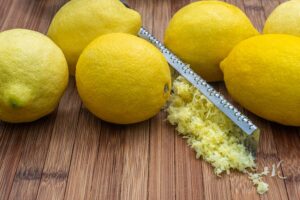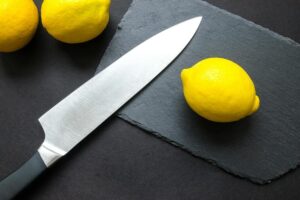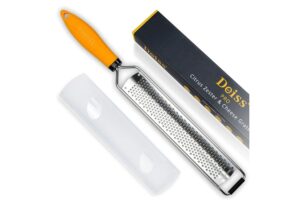The outermost layer of a lemon’s peel contains highly concentrated essential oils. It is prized for its strong intense lemon flavor and plethora of uses.

Lemon zest is a versatile ingredient. It can be used in sauces, dressings, marinades, baked goods, cocktails, and more. To extract this zest, many use a grater. However, if a grater isn’t within reach, there are other ways to zest a lemon.
Can You Zest Lemon Without a Grater?
Yes, you can zest a lemon without a grater. Instead of a grater, you can use other alternatives like a fine microplane, a citrus zester, or a knife.
You can use these to carefully remove the outer zest. Otherwise, you can even use a peeler to peel off the zest and then finely chop it.
When using these methods, just be cautious not to remove the bitter white pith along with the zest.
What Are Some Alternative Methods to Zest a Lemon Without a Grater
Use a Microplane
Microplane is a brand of rasp grater and has slowly become the generic name for a rasp grater. Using a microplane zester is the easiest and most efficient way to zest a lemon.
Microplane is a fine-toothed kitchen tool that allows you to grate the zest finely and easily. It’s one of the most efficient alternatives to a traditional grater.
How to Zest a Lemon With a Microplane
Here’s the simple process of zesting a lemon with a microplane. Of course, you’ll start by washing the lemon thoroughly to remove any dirt or contaminants from the skin.
Since you’ll be using a microplane instead of a grater, get that ready. Hold the microplane in one hand with a firm grip, making sure the sharp side is facing up.
With the lemon in your other hand, gently drag it across the microplane. Use light pressure and make sure to only remove the outer, colored part of the lemon peel. Avoid grating the white pith beneath the skin, as it can be bitter.
Rotate the lemon: As you zest, rotate the lemon to get an even amount of zest from the entire surface. Be cautious not to over-zest in one spot.
Collect the zest: The lemon zest will fall onto the microplane or a plate below. You can then use a small brush or spatula to collect the zest.
Use a Knife

With a sharp knife, you can carefully peel off the zest, avoiding the bitter pith, and then finely chop it. This method requires more precision and a steady hand than using a microplane.
How to Zest Lemon Using a Knife
Make sure you’re using a sharp knife. You could use a sharp paring knife or a chef’s knife with a thin, pointed blade.
Trim a small portion from both ends of the lemon to create flat surfaces. This will make it easier to work with.
Create strips or ribbons: Hold the lemon with one hand and use the knife to make very thin strips or ribbons of the zest. Make sure to cut away only the colored part of the lemon peel. Avoid the bitter white pith underneath.
As you zest, rotate the lemon to get an even amount of zest from the entire surface. Be careful not to cut too deeply.
Collect the zest: As you create zest strips, you can use your knife or your fingers to collect them. Be gentle to avoid damaging the zest.
Chop or use the zest: If you prefer smaller zest pieces, you can finely chop the strips created with the knife. Alternatively, you can use the strips as they are, depending on your recipe.
Zesting with a knife takes a bit more skill than using a microplane. Therefore, it is important to be cautious to avoid cutting yourself and to get the zest without the pith.
Use a Peeler
A vegetable peeler can be also used to peel off larger strips of zest. You can then chop them into smaller pieces or strips for your lemon zest recipes.
The issue with using a vegetable peeler is that you don’t have one that is powerful enough. Also, peelers tend to scrape off the white pith underneath.
Therefore, this particular method should be used if you are an experienced cook or baker.
How to Zest Lemon With a Peeler
First, ensure you’re using the right peeler, specifically a vegetable peeler. Use one with a sharp, thin blade. A Y-shaped peeler or a straight peeler will work well.
Hold the lemon firmly in one hand and gently run the peeler along the surface of the lemon. Apply light pressure. Be careful not to press too hard. You want to remove only the outer zest, not the bitter white pith underneath.
Rotate the lemon as you peel, so you get even strips of zest from all sides.
As you peel, the zest will come off in thin strips or curls. Collect the zest in a bowl or on a clean surface.
Use a Citrus Zester

If you don’t have a grater, you can use a specialized citrus zester. These are specially designed to create thin strips of zest.
If you want larger zest curls or slices, there are also citrus zesters that work best. Larger lemon zest is ideal for garnish, cocktails, or mocktails.
How to Zest Lemon With a Citrus Zester
Using a citrus zester to zest a lemon is quite straightforward.
Hold the lemon securely with one hand. For safety, Keep your fingers away from the zesting surface to avoid accidental cuts.
Hold the citrus zester in your other hand. Ensure that the sharp edges of the zester are facing away from you.
Gently drag the zester across the surface of the lemon with light pressure. Move the zester in one direction, from top to bottom, to remove the zest.
You Can Use the Score and Scrape Method
Another technique involves scoring the lemon peel which is making shallow cuts on the surface. Then, scrape the zest off with the edge of a spoon.
How to Score and Scrape Lemon Zest
First, use a sharp knife or a citrus zester to Score the lemon peel. make shallow cuts or scores in the lemon peel. These cuts should be about 1/8 to 1/4 inch apart.
Be careful not to cut too deep as you want to score only the outer zest.
Next, scrape the zest. After scoring the lemon, take the edge of a spoon, and gently scrape it along the scored areas.
Alternatively, you can use the back of a butter knife, or a citrus zester. The zest should come off in small strips as you scrape.
Final Tip
Ensure the tool you’re using is sharp enough. A sharp knife or microplane allows you to zest the lemon more efficiently and with less effort.
Dull tools may require excessive pressure and this can lead to uneven zests or accidental inclusion of bitter pith. Sharp tools provide better control.
You can extract only the fragrant outer zest and avoid the bitter white pith. These alternative methods are quite effective when a grater is not available.
However, they require more manual effort and precision to ensure you get the zest you want without any bitterness.
